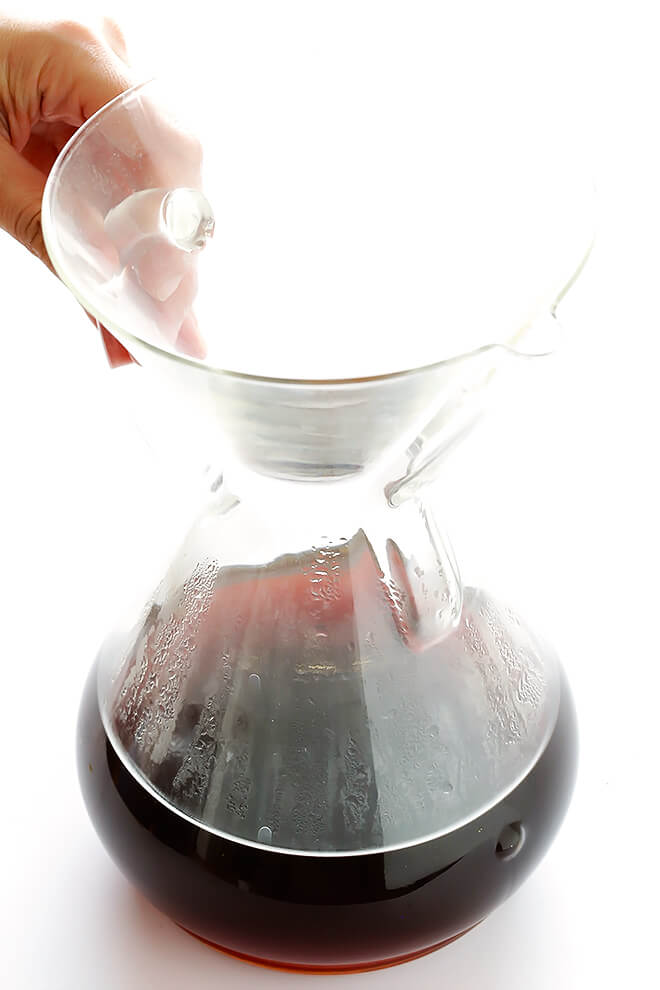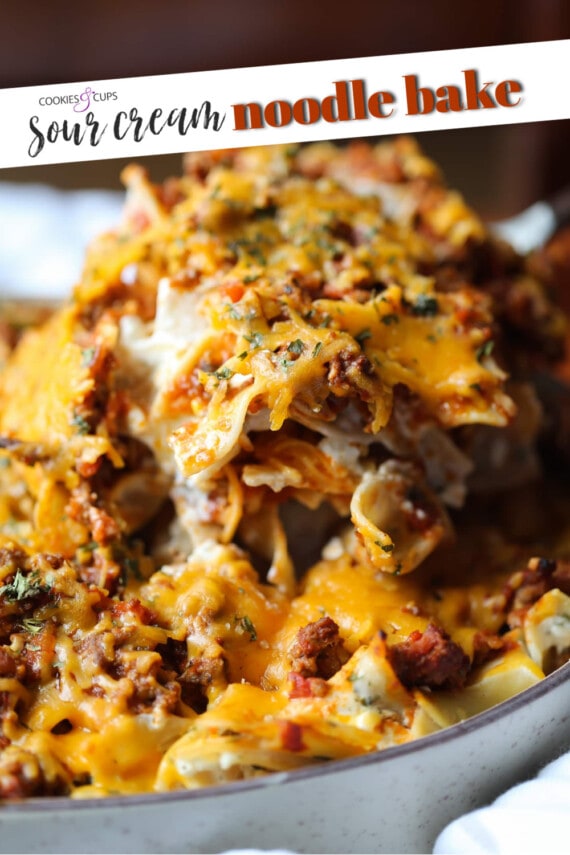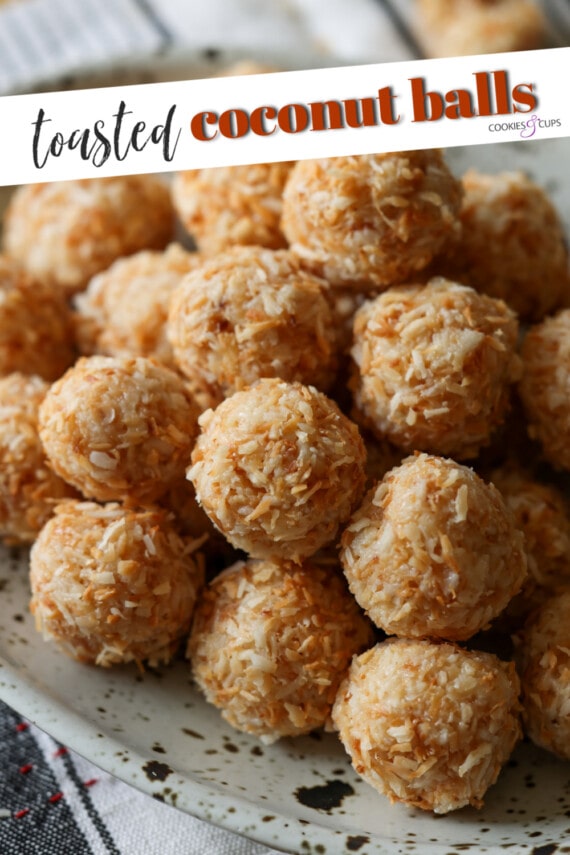Pour-Over Coffee
Easy5 minsQuick
Learn how to make pour-over coffee with this simple photo and video tutorial. Plus, I’ve included recommendations of my favorite coffee equipment.
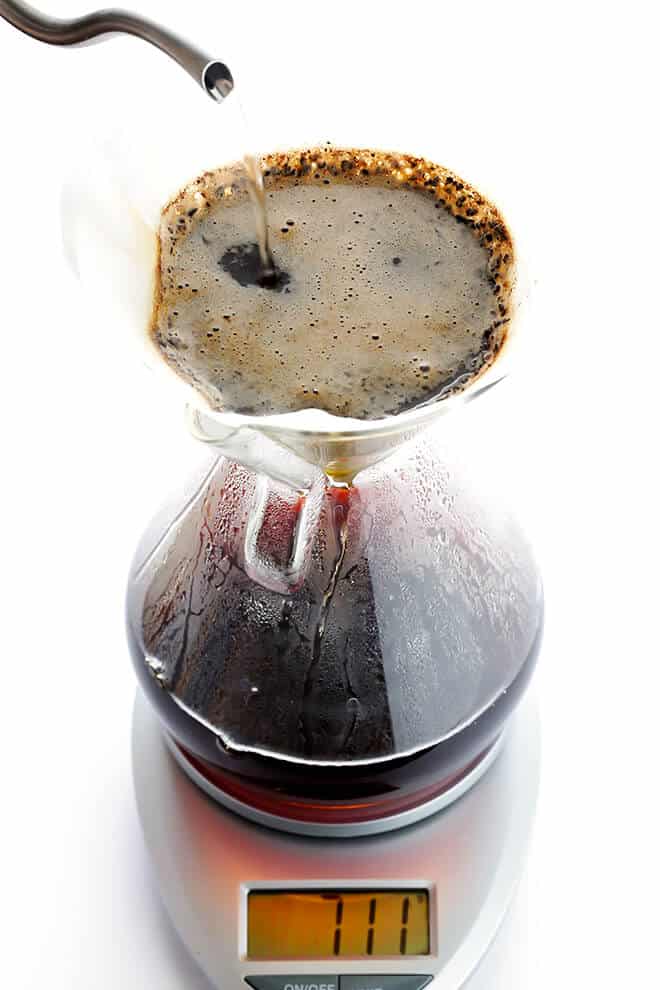
Have you ever tried making pour-over coffee before?
I got hooked on the slower brewing method about five years ago when I first moved down to the River Market neighborhood in Kansas City. I happened to be unloading all of my things into a sixth-floor loft on the very same hot June day that Quay Coffee was having their grand opening. I decided to wander down the next morning to check it out. And I distinctly remember that, as I ventured in the door, feeling that familiar mix of nerves-excitement-adrenaline about having just woken up alone in my brand new neighborhood, this sudden wave of peace washed over me. And I felt so at home.
The vibe of the place was tranquil and cool. The baristas were warm and friendly. The place was bustling with customers who were thrilled about the new neighborhood spot. And I knew right away that this was going to become my “spot”.
Five years, and hundreds and hundreds of cups of coffee later, this place has been exactly that. My home away from home. ?
Ha, that said, I also have a very clear memory that day of walking up to the counter and having zero idea what to order, since there were only some random countries listed on the menu. ? Turns out that Quay was one of the first coffee shops in our area, back in the day, that had decided to focus primarily on pour-over coffee, ethically sourced from great brewers around the world. As a French press girl, I had never heard of the method. But as I chatted with the barista, and watched as the he slowly poured the water over the grounds, round and round, round and round, I quickly began to fall in love with the rhythm of pour-over. And after my first sip, I was completely hooked.
For those of you who have never tried pour-over coffee, it’s a really simple hand-brewing method that — at least in my opinion — makes the most of good coffee beans. The flavor is incredibly clean, bright and round, and avoids that slightly burned/charred taste that can occur in drip or French press coffee (when the beans spend more time in contact with the hot water). It does require more of your attention than drip or French press coffee, but I actually really enjoy the rhythm of it in the mornings. And it still only takes about 5 minutes from start to finish.
Admittedly, I still walk over to Quay most mornings and enjoy ordering a pour-over as I slowly wake up and chat with the baristas and say hi to neighbors and open my laptop to begin the day’s work. But on the mornings when I’m at home, I love pulling our my Chemex and making a batch for myself, pouring the water round and round, round and round. It’s just the best. So if you’ve ever wanted to try it for yourself, here are all of my tips, plus a (new!) video to take you step by step through the brewing process.
What is Pour-Over Coffee?
Alright, let’s begin with the basics. Pour-over is a method of drip coffee in which water is poured in a very steady and slow stream over a filter cone. There are many benefits to the method, but I especially love it because the coffee tastes bright and clean and round, without the bitterness or charred taste that can come with traditional drip or French press methods.
Pour-Over Coffee Equipment
There is all sorts of fancy equipment that you can buy to make pour-over coffee. But the basic essentials you need include the following:
- Pour-Over Brewer
- Coffee Grinder
- I strongly recommend investing in a burr grinder that allows you to choose the coarseness of your grind. (Medium coarseness works best for pour-over coffee.)
- Suggested Grinders: Mr. Coffee Burr Grinder (less expensive), KitchenAid Burr Grinder (my fave)
- Slow-Pour Kettle
- Coffee Filters
- Digital Kitchen Scale
- To make the best pour-over coffee, you really need a digital kitchen scale to measure the weight of the coffee and water. No need for anything fancy — just something that measures in grams will do!
- Suggested Digital Kitchen Scale: Eatsmart Precision Pro Digital Kitchen Scale
How To Make Pour-Over Coffee:
Just follow these basic steps:
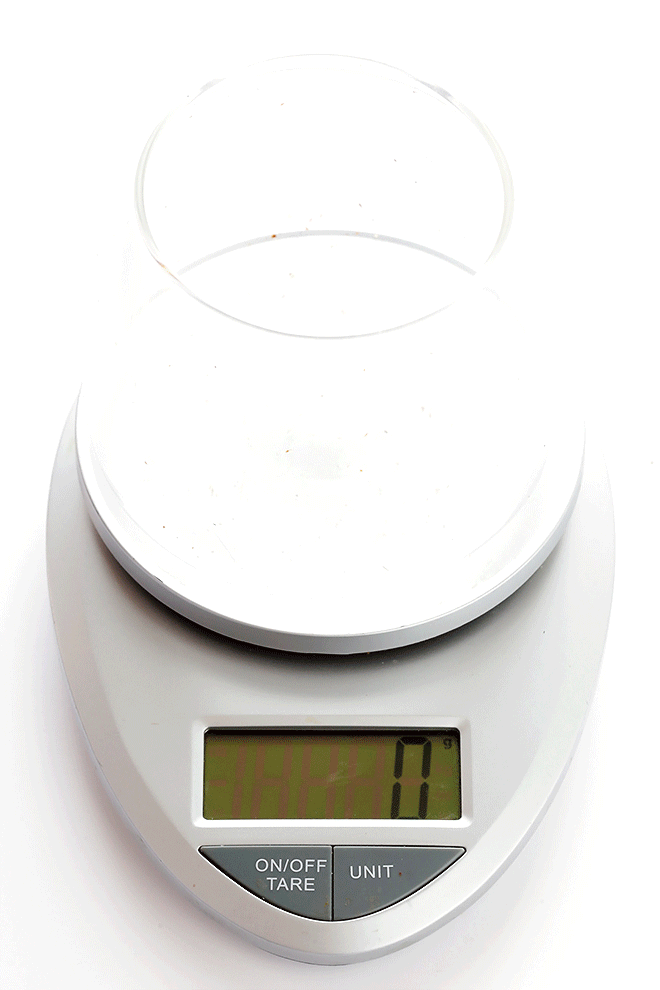
Step 1: Grind the beans
Fresh beans are always, always better with coffee. So grab your scale and tare it out. Then measure out 48 grams of beans, and grind them to medium-coarseness.
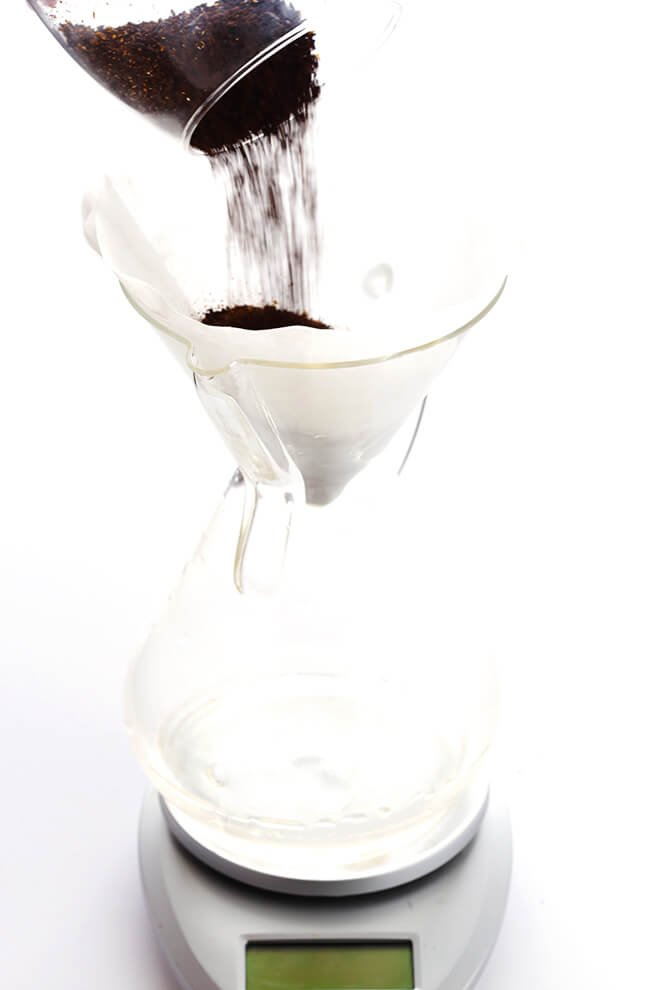
Step 2: Rinse The Filter
Place a filter in the top of the Chemex, and with the double-folded side of the filter facing the spout. Use a slow-pouring kettle to pour the water all over the filter until it is completely soaked. This “rinse” will help remove the paper-y taste from the filter and preheat it. Once the filter is completely rinsed, carefully pour out the water in the Chemex, and place the filter back in its spot.
Pour the ground coffee beans into the bottom of the filter, and give the Chemex a small shake to even out the grounds. Then place the Chemex on a digital scale and tare it out so that it begins at 0 grams.
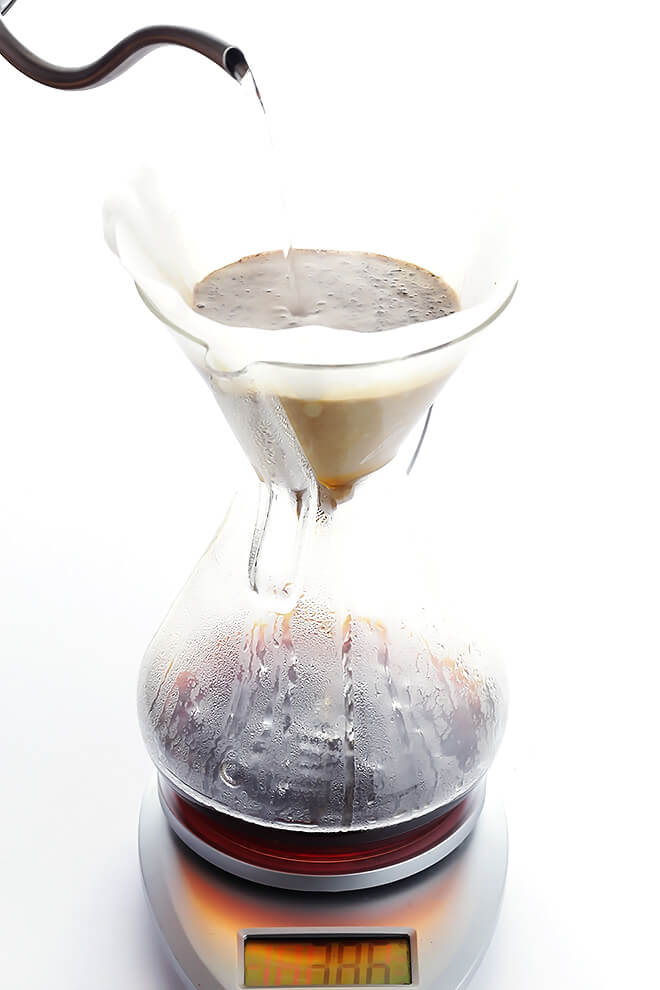
Step 3: Pour, pour, pour, pour
Pour #1: Using a zig-zag motion, pour water over the grounds until they are completely wet (and the scale measures approximately 80 grams). Wait 30-45 seconds for the grounds to puff up and “bloom”, which allows the gasses to release from the coffee grounds.
Pour #2: Then starting from the center and moving outward in slow concentric circles, continue pouring water in a steady stream to rewet the grounds, careful not to pour directly along the edges of the filter. Pour until the scale measures 300 grams, then wait for the water to mostly drain.
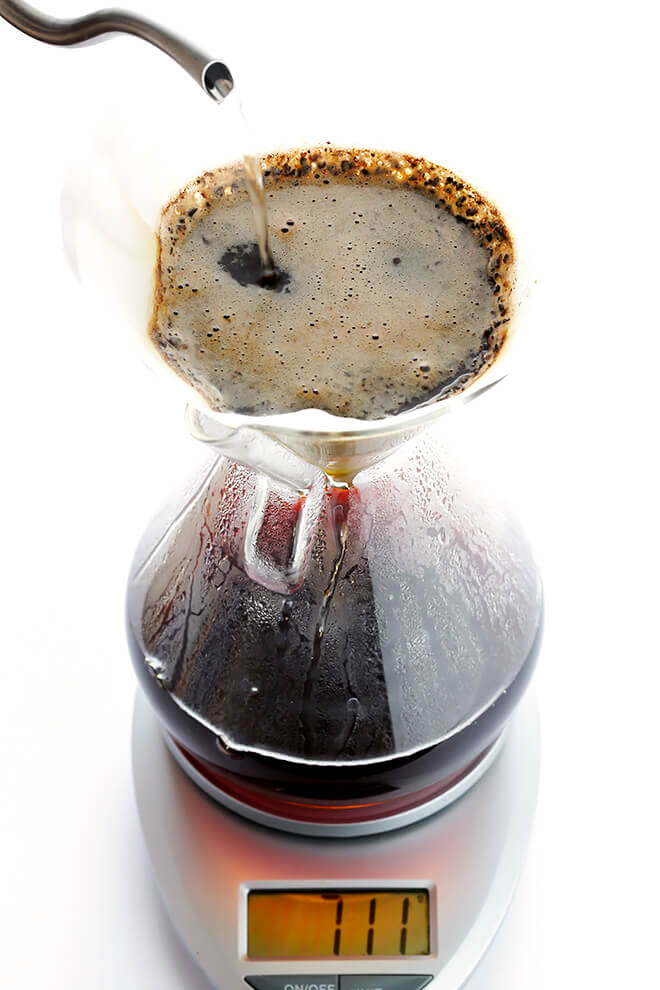
Pour #3: Pour another round of water over the grounds in concentric circles until the scale measures 600 grams, then wait for the water to mostly drain.
Pour #4: Then pour a final round of water over the grounds in concentric circles until the scale measures 750 grams.
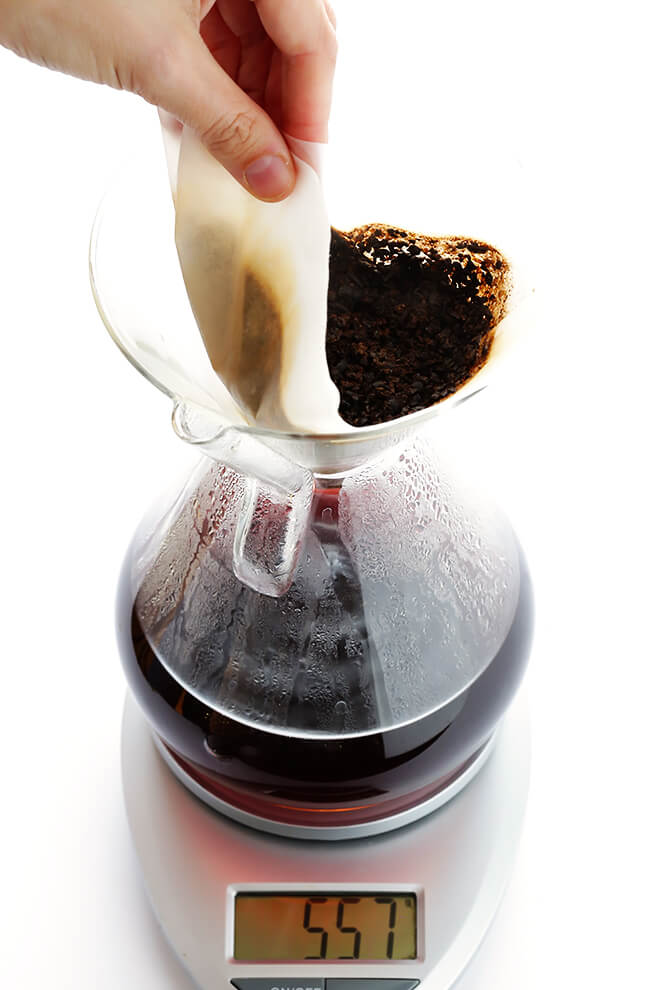
Step Four: Remove The Filter & Serve!
Once most (not all) of the water has drained from the final round, carefully remove the filter. (Be careful, it’s hot!) Don’t wait until all of the water has drained out, or else some of the final drops can be really bitter.
Then pour the coffee into your favorite serving cups, and enjoy!
Video Tutorial:
Here’s a step-by-step video, just to take the guesswork out of the whole pouring process. 😉

Yield: 1-2 servings
How To Make Pour-Over Coffee
Learn how to make delicious pour-over coffee with this easy recipe.
Ingredients:
- 3.5 cups water
- 48 grams good-quality whole coffee beans
Directions:
- In an electric kettle, teapot or water heater, bring about 3.5 cups water to a *boil (see note below). Meanwhile, use a digital kitchen scale to weigh 48 grams of coffee beans.
- Grind the beans using a hand or electric grinder to medium coarseness.
- Place a filter in the top of the Chemex, and with the double-folded side of the filter facing the spout. Use a slow-pouring kettle to pour the water all over the filter until it is completely soaked. This “rinse” will help remove the paper-y taste from the filter and preheat it. Once the filter is completely rinsed, carefully pour out the water in the Chemex, leaving the filter in its place.
- Pour the coffee grinds into the bottom of the filter, and give the Chemex a small shake to even out the grounds. Then place the Chemex on a digital scale and tare it out so that it begins at 0 grams.
- Using a zig-zag motion, pour water over the grounds until they are completely wet (and the scale measures approximately 80 grams). Wait 30-45 seconds for the grounds to puff up and “bloom”, which allows the gasses to release from the coffee grounds.
- Then starting from the center and moving outward in slow concentric circles, continue pouring water in a steady stream to rewet the grounds, careful not to pour directly along the edges of the filter. Pour until the scale measures 300 grams, then wait for the water to mostly drain.
- Pour another round of water over the grounds in concentric circles until the scale measures 600 grams, then wait for the water to mostly drain.
- Then pour a final round of water over the grounds in concentric circles until the scale measures 750 grams.
- Once most (not all) of the water has drained from the final round, carefully remove the filter. (Be careful, it’s hot!) Don’t wait until all of the water has drained out, or else some of the final drops can be really bitter.
- Pour and serve!
*For best results, use water that is 195-205°F. But if you do not have a thermometer, bring water to a boil. Then remove from heat and let it rest for 30 seconds, and then use immediately.
**For iced coffee lovers, be sure to read this article about iced coffee and cold brewing from Prima Coffee.
Difficulty: Easy
Category: Quick
If you make this recipe, be sure to snap a photo and hashtag it #gimmesomeoven. I’d love to see what you cook!

